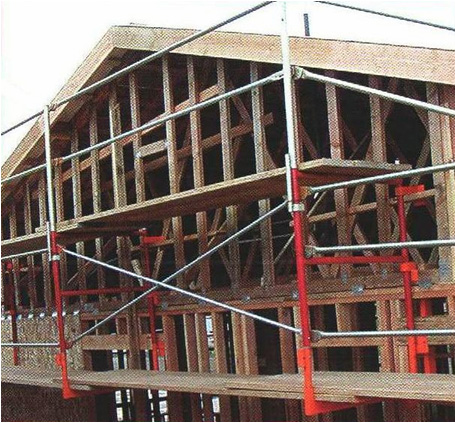- Standard Number:
OSHA requirements are set by statute, standards and regulations. Our interpretation letters explain these requirements and how they apply to particular circumstances, but they cannot create additional employer obligations. This letter constitutes OSHA's interpretation of the requirements discussed. Note that our enforcement guidance may be affected by changes to OSHA rules. Also, from time to time we update our guidance in response to new information. To keep apprised of such developments, you can consult OSHA's website at https://www.osha.gov.
April 21, 2004
Mr. Dave Cave
Jax Scaffold Systems, LLC
999 Linda Vista Drive, Suite B
San Marcos, CA. 92069
Re: Does the Jax Scaffold System meet OSHA scaffold requirements when installed during the construction of wood-framed buildings in accordance with manufacturer instructions?
Dear Mr. Cave:
This is in response to your package received Feb 13, 2003, to the Occupational Safety and Health Administration (OSHA) regarding the "Jax Scaffold System." We apologize forthe delay in responding.
We have paraphrased your question as follows:
Question: I have enclosed information about our product, the Jax Scaffold System. Does it comply with the scaffold requirements in §1926.451(g)?
Answer
OSHA is generally precluded from approving or endorsing specific products. The variable working conditions at job sites and possible alteration or misapplication of an otherwise safe piece of equipment could easily create a hazardous condition beyond the control of the equipment manufacturer. However, where appropriate, we try to give some guidance to help employers assess whether products are appropriate to use in light of OSHA requirements.
Based on the descriptions of your scaffold system in the installation guide and brochure you submitted, we understand the system to consist of the following:

The medium-duty Jax scaffold system is intended to provide exterior fall protection during wood framing and roof sheathing activities on structures constructed of 2x4 and 2x6 framing. Your instructions state that it is to be installed by at least one "qualified, certified" person prior to the hoisting and staging of trusses and after the walls of the structure are plumb and sufficiently braced at all bracket locations (as specified in the instructions). The scaffold system is made of galvanized metal guardrails, scaffold planks, and metal support brackets, which are supported by the vertical studs of the walls. The support brackets are first held in place with two 16D duplex nails and then secured with four Simpson .25" x 1.5" SDS screws. You call for the system to be inspected at the beginning of each shift and for conventional fall protection to be used during its dismantling.
You provided test results from a testing laboratory that you state show that when your railing and bracket system is anchored to simulate field connections, it meets the 200-lb. force requirement for toprails in §1926.451(g)(4)(vii), which states:
Each toprail or equivalent member of a guardrail system shall be capable of withstanding, without failure, a force applied in any downward or horizontal direction at any point along its top edge at of at least 100 pounds (445 n) for guardrail systems installed on single-point adjustable suspension scaffolds, and at least 200 pounds (890 n) for guardrail systems installed on all other scaffolds.
Similarly, you state that the results show that the support brackets, when anchored to simulate field connections, meet a 4:1 safety factor when the specified maximum load of 500 lbs is applied. The 4:1 safety factor is required by §1926.451(a), Capacity, which states:
Except as provided in paragraphs (a)(2), (a)(3), (a)(4), (a)(5), and (g) of this section, each scaffold and scaffold component shall be capable of supporting, without failure, its own weight and at least 4 times the maximum intended load applied or transmitted to it.
We do not have the resources to independently assess the test results. However, if accurate, the test results indicate that these strength requirements have been met.
The load-bearing capabilities of the Jax Scaffold System are dependent upon the strength and stability of the wooden framework to which it is attached. We note that you have provided specific instructions in your "Installation Guide" regarding what type/configuration of framework is required to support the scaffold system.
If you need additional information, please contact us by fax at: U.S. Department of Labor, OSHA, Directorate of Construction, Office of Construction Standards and Guidance, fax # 202-693-1689. You can also contact us by mail at the above office, Room N3468, 200 Constitution Avenue, N.W., Washington, D.C. 20210, although there will be a delay in our receiving correspondence by mail.
Sincerely,
Russell B. Swanson, Director
Directorate of Construction

